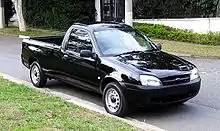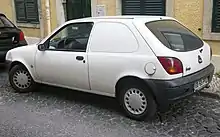Ford Fiesta (fourth generation)
History
| Fourth generation | |
|---|---|
_front.jpg.webp) | |
| Overview | |
| Also called | Mazda 121 Mazda 121 Soho (South Africa) Ford Fiesta Street (Brazil) |
| Production | October 1995–December 2002 (Europe) 1996–2006 (Brazil) |
| Assembly | Almussafes, Spain (Ford Valencia) Dagenham, United Kingdom (Ford Dagenham) Cologne, Germany (CB&A) Saarlouis, Germany (SB&A) São Bernardo do Campo, Brazil (Ford Brazil) Chongqing, China (Changan Ford Mazda) Pretoria, South Africa |
| Body and chassis | |
| Body style | 3/5-door hatchback 3-door panel van 4-door sedan 3-door high cube panel van (Courier) 2 door coupé utility (Courier) |
| Platform | Ford B platform |
| Related | Ford Ka Ford Puma (first generation) Ford Ikon |
| Powertrain | |
| Engine | 1,299 cc (79.3 cu in) Kent/Endura-E I4 1,242 cc (75.8 cu in) Zetec-SE I4 1,388 cc (84.7 cu in) Zetec-SE I4 1,753 cc (107.0 cu in) Endura-D I4 1,753 cc (107.0 cu in) Endura-D I4 |
| Transmission | 5-speed IB5 manual CVT automatic |
| Dimensions | |
| Wheelbase | 2,446 mm (96.3 in) |
| Length | 3,828 mm (150.7 in) |
| Width | 1,634 mm (64.3 in) |
| Height | 1,320 mm (52 in) |
| Curb weight | 924 kg (2,037 lb) |
| Chronology | |
| Predecessor | Autozam Revue (for Mazda) |
_rear.jpg.webp)

The Fiesta Mark IV (internal code name was BE91)[1] was launched in October 1995[2][3][4] and became Britain's best-selling car from 1996 to 1998, when it was overtaken by the all-new Ford Focus, a replacement for the Ford Escort.
The Mark IV benefited from new interior and exterior styling. It maintained similar dimensions to the Mark III along with the platform and the basic body structure, most noticeably the side door openings. The RS1800 and RS Turbo models were not carried over to the updated Fiesta range.
The model featured a range of new Zetec-SE engines, available in 1.25 L and 1.4 L forms; the 1.8 litre diesel engine was slightly modified for the Mark IV, now marketed as the "Endura DE". Lower specification models remained available with what would be the final edition of the Kent 1.3 L OHV engine, now known as Endura-E.
As an exercise in badge engineering, the Mazda 121 and Ford Fiesta Mark IV shared their design, were built on the same production lines and used almost all the same parts.[5] In the JD Power reliability surveys at the time, the Mazda was reported to be significantly more reliable and attracted higher levels of customer satisfaction, despite it being a slower seller than the Fiesta.
In Brazil a 1.0 litre (Endura Engine) version was available in Popular trim level. Also a 1.3 litre (Endura) and a 1.4 litre 16V (Zetec-SE) was available in CLX trim level; it was sold in Argentina and Chile. The UK trim level line up had relatively few changes over the years: (1995, Encore, LX, Si, Ghia; 1996, Ghia X added as range-topper; 1998, Si replaced by Zetec, petrol LX models briefly renamed Zetec LX, Ghia X models axed; 1999, Finesse added between Encore and Zetec).
In 1997, the Mark IV was introduced in South Africa, the first time the Fiesta had been sold in that market. Only one engine was available, the 1.3 litre Endura E. It subsequently won the South African Car of the Year award. The 1.3 litre engine was replaced with the 1.4 litre PTE (CVH) engine in 1999. It was also sold locally as the Mazda 121 Soho, although it is often referred to simply as the "Mazda Soho".[6]
The Mark IV was not sold in North America.
The German-built Ford Puma was based on the Mark IV, sharing its underpinnings. For this reason the 1.7 VCT engine from the Ford Puma has become an extremely popular engine swap into the Mark IV and Mark IV facelift Fiesta. This gives the popular hatchback an extra 100 cc over the previous largest engine size available, variable cam timing and better ratio gearbox while still retaining a factory finish as all components are a direct swap.
Specifications
| Engine type(s) | Inline-four engines: Petrol, Ford Kent/Endura-E (OHV), Zetec-SE (OHC), and Diesel (OHC) |
|---|---|
| Capacity | Petrol: 1,242–1,596 cc (75.8–97.4 cu in) Diesel: 1,753 cc (107.0 cu in) |
| Power | 59–91 bhp (44–68 kW) |
| Max. speed | 96–112 mph (154–180 km/h) |
| Acceleration | 0-62 mph (100 km/h): 1.25 Zetec: 11.9 s |
| Fuel efficiency | 38–46 mpg-UK (32–38 mpg-US or 7.4–6.1 L/100 km) |
Facelift




In 1999, the Fiesta received a secondary facelift[3][7] aimed at giving the car a New Edge look, with a Focus-inspired face, new bumpers and wheel designs. The facelift is sometimes referred to as Mark V in the United Kingdom and elsewhere.
Other changes include 1.6i 16V Zetec engine, fitted to the new Zetec S model, and later available in Ghia and Freestyle trims. New features were made available, such as side airbags and (after launch) the reintroduction of leather trim. An environmentally friendly E-Diesel model was released for 2001, with CO2 emissions of 120 g/km. The Lynx 1.8 TDDi engine was also introduced after launch.
The fourth generation facelift was the last generation of Fiesta to be built at Dagenham in England, and was indeed the final Ford model to be built at Dagenham prior to the closure of the car assembly plant in 2002. The internal code name of this Fiesta was still BE91. The UK trim level line-up consisted of: 1999, Encore, Finesse, Zetec, LX, Ghia; 2000, Zetec S added; 2001, E-Diesel added at bottom of range. Seeing the production of the fifth generation Fiesta, the Flight and Freestyle trims were respectively replaced by Finesse and Zetec.
In South Africa, the facelift used the Port Elizabeth-built 1.3 L and 1.6 L Rocam engines, instead of the European Sigma 16-valve engines. This model formed the basis of the Ford Ikon (code name C195), which is a four-door saloon designed for India, where Ford was then producing cars in a joint venture with Mahindra. The Ikon was also introduced in other developing countries, such as Brazil (where it is known as the Fiesta Sedan), South Africa, Mexico (where it was called Fiesta Ikon) and China, where saloons are preferred to hatchbacks. They are extremely reliable, and became one of Ford's successes.
There were also four utility variants, the simplest being the "Fiesta Van" which was a three-door hatchback with the rear quarter windows blanked over and the rear seat omitted (in other words, a sedan delivery). Another van with a boxy rear body and stretched wheelbase used the Courier nameplate and formed the basis of two coupe utility models, one with the short doors of the 5-door hatchback and small quarterlights in the style of larger extended cab pick-ups, made in South Africa as the Ford Bantam; and another with the 3-door's longer doors and no quarter windows, made in Brazil as the Ford Courier.
The Fiesta was still Britain's best-selling supermini in 2001, by which time it was making use of a design over a decade old (though heavily updated visually and mechanically). In three-door form, it was sold alongside the fifth generation Fiesta from April to December 2002 and in its final years in Brazil, it was sold as the Fiesta Street until 2006.
Zetec S
The Zetec S was the highest Fiesta trim, and although its 1.6 L 16v Sigma engine was available in other Fiestas (such as the Freestyle) the Zetec S pushed out 101 bhp (75 kW; 102 PS),[8] and had major alterations to the suspension, with stiffer anti-roll bars and uprated brakes shared with the Puma.
The fifth generation facelift Zetec S has a sizeable following, with many websites dedicated to the vehicle. There is also a tuning culture devoted to this model, with reputable companies such as Milltek Sport and Shawspeed developing performance parts solely for the Sigma engine.
Specifications
| Engine type(s) | Inline-4: Petrol, Ford Kent/Endura-E (OHV), Zetec-SE (OHC), and Diesel (OHC) |
|---|---|
| Capacity | Petrol: 1,242–1,596 cc (75.8–97.4 cu in) Diesel: 1,753 cc (107.0 cu in) |
| Power | 59–103 bhp (44–77 kW) |
| Max. speed | 95–118 mph (153–190 km/h) |
| Acceleration | 0–60 mph (97 km/h) 9.9–16.9 seconds |
| Fuel efficiency | 38–53 mpg-UK (32–52 mpg-US or 7.4–4.6 L/100 km) |
References
- Cleveland, Rob (March 1, 1996). "Vive la difference: Ford's Richard Parry-Jones relishes challenges of world cars". Archived from the original on July 16, 2017.
- de Partz, Yves (September 16, 1995). "Francfort, un salon exceptionnellement riche". Le Soir. Archived from the original on March 18, 2019.
- "Still going strong, Ford's youthful-spirited Fiesta is celebrating its 30th birthday" (PDF). Ford Motor Company. August 25, 2006. Archived from the original (PDF) on September 30, 2008.
- "Ford Fiesta becomes Best-Selling UK Car of All Time". Ford Motor Company. July 22, 2014.<
- de Partz, Yves (March 16, 1996). "La petite 121 bonne aussi pour la route". Le Soir.
- Samcor Mazda Soho: Tom Cruise, Brad Pitt, Meg Ryan, May 26, 1998
- "Ford Fiesta Global Heritage" (PDF). Media.Ford.com. April 2010. Retrieved April 30, 2010.
- "Facts & Figures: Ford Fiesta (99-03) 1.6 Zetec S 3d". Parkers.co.uk. Archived from the original on September 28, 2011. Retrieved March 18, 2011.
External links
 Media related to Ford Fiesta MK4 at Wikimedia Commons
Media related to Ford Fiesta MK4 at Wikimedia Commons Media related to Ford Ikon at Wikimedia Commons
Media related to Ford Ikon at Wikimedia Commons Media related to Mazda 121 (JASM/JBSM) at Wikimedia Commons
Media related to Mazda 121 (JASM/JBSM) at Wikimedia Commons